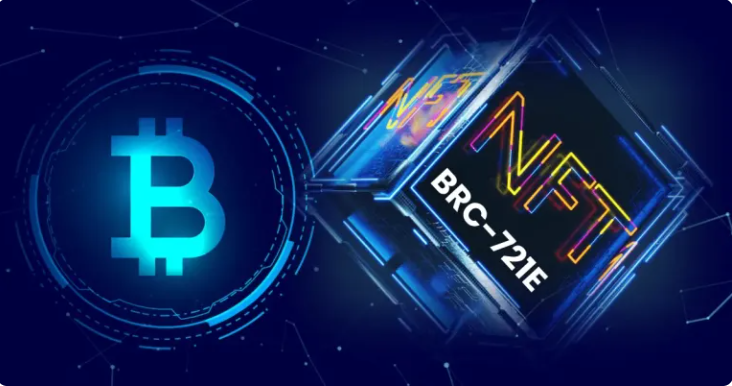Recently, NFTs on Bitcoin are being mentioned as a new investment opportunity for investors. And recently BRC 721E appeared as a solution to help transfer NFTs from Ethereum to the Bitcoin blockchain. This opens up enormous potential for the development of NFTs on Bitcoin. So what’s special about BRC 721E? Let’s find out with Weakhand in this article.
What is BRC 721E?
Birth history of BRC 721E
Although Bitcoin Ordinals has only been around since early 2023, it has already attracted many developers with many different solutions to improve the quality of NFTs on the Bitcoin network.
As a new breakthrough solution, the recently launched BRC 721E standard in a collaborative effort between Ordinals market and the Bitcoin Miladys NFT project allows users to transfer their ERC 721 NFTs from Ethereum to the Bitcoin network. This opens up a new potential for investors in the NFT community who may be looking for new investment opportunities beyond the Ethereum blockchain.
Introduction to BRC 721E standard

What is BRC 721E?
This process involves sending ERC 721 NFTs to a Burn address making them inaccessible. Users then need to pay Gas fees to write the NFT into the Bitcoin blockchain. While the BRC 721E standard does not store metadata directly on the Bitcoin blockchain, it does provide a solution for users to store lower-resolution preview images on-chain. This innovative approach paves the way for seamless asset conversion between Ethereum and Bitcoin while preserving the unique properties and provenance of the original NFT.
Adoption of ERC 721 Standard with Additional Features
The BRC 721E standard is built on Ethereum’s ERC 721 standard, a standard that has been widely recognized by the NFT user community on Ethereum. However, BRC 721E still has interesting additional features designed specifically for NFTs on the Bitcoin blockchain.
Enhance security capabilities
One of the special features of the BRC 721E is its ability to support decentralized NFT metadata storage. This metadata refers to NFT information such as: Name, image, other information describing the NFT. On the Ethereum blockchain Metadata is stored on centralized servers making it vulnerable to censorship and potential attacks.
However, the BRC 721E standard takes a different approach by storing Metadata on the Bitcoin blockchain itself with only image data stored on IPFS servers. This feature helps ensure Metadata is secure and accessible to everyone.
Revolutionize the creation and use of NFTs
Although the BRC 721E standard is still in its early stages, it offers much potential in revolutionizing the NFT world. By reinforcing the security and flexibility of Bitcoin and the tight connection between the Ethereum and Bitcoin blockchains, it ensures that NFTs created using BRC 721E have seamless interoperability between the two platforms.
Key Features and Benefits of BRC 721E
The BRC 721E standard offers a range of exciting features for users. Let’s take a look at some of the features of the BRC 721E.
Airdrop capability
Due to inheriting many superior features of ERC 721. Therefore, NFT collections that apply the BRC 721 standard can also deploy airdrop programs for the community as well as their Holders.
Cost savings
The BRC 721E standard provides an efficient solution that significantly reduces the cost of transferring NFTs from Ethereum to Bitcoin. Additionally, BRC 721E allows users to preview quality images throughout the Ethereum to Bitcoin transfer process.
Increase visibility
NFT collectibles using the BRC 721E standard will automatically be listed on popular Ordinals Markets. This increases the visibility and exposure of NFT Collections. This is also an attraction for artists and creators on a new path to reach more users.
Advantages and Disadvantages of BRC 721E
Advantages of BRC 721E
Let’s go into some advantages of BRC 721E as follows:
- Security: By storing metadata on the Bitcoin network, BRC 721E provides high security and protection from potential attacks.
- Flexibility: Inheriting the flexibility of ERC 721, NFTs based on the BRC 721E standard have the potential to open up new markets with endless creative possibilities and attract more users.
- Interactive abillity: The BRC 721E standard seamlessly integrates both the Ethereum and Bitcoin blockchains allowing NFTs to be used across multiple platforms. This ensures BRC 721E reaches more users on Ethereum and better liquidity.
Disadvantages of BRC 721E
Although the BRC 721E standard offers interesting benefits, it also has a few disadvantages:
- Lack of acceptance: As a new standard, BRC 721E has not yet been widely accepted by users in the community. Therefore, the development ability of projects using BRC 721E standards will have difficulty reaching the community.
- Technical complexity: The BRC 721E standard is more complex than the ERC 721 standard. This complexity makes it difficult for developers and causes major challenges in complying with this standard.
summary
BRC 721E ushers in a significant development for NFTs on Bitcoin. High security capabilities along with seamless interoperability have created a promising future for BRC 721E. Although at present the BRC 721E is only in the early stages of development, its potential is undeniable. As the NFT space continues to grow, BRC 721E will surely see improvements to become one of the popular standards on the Bitcoin network.


